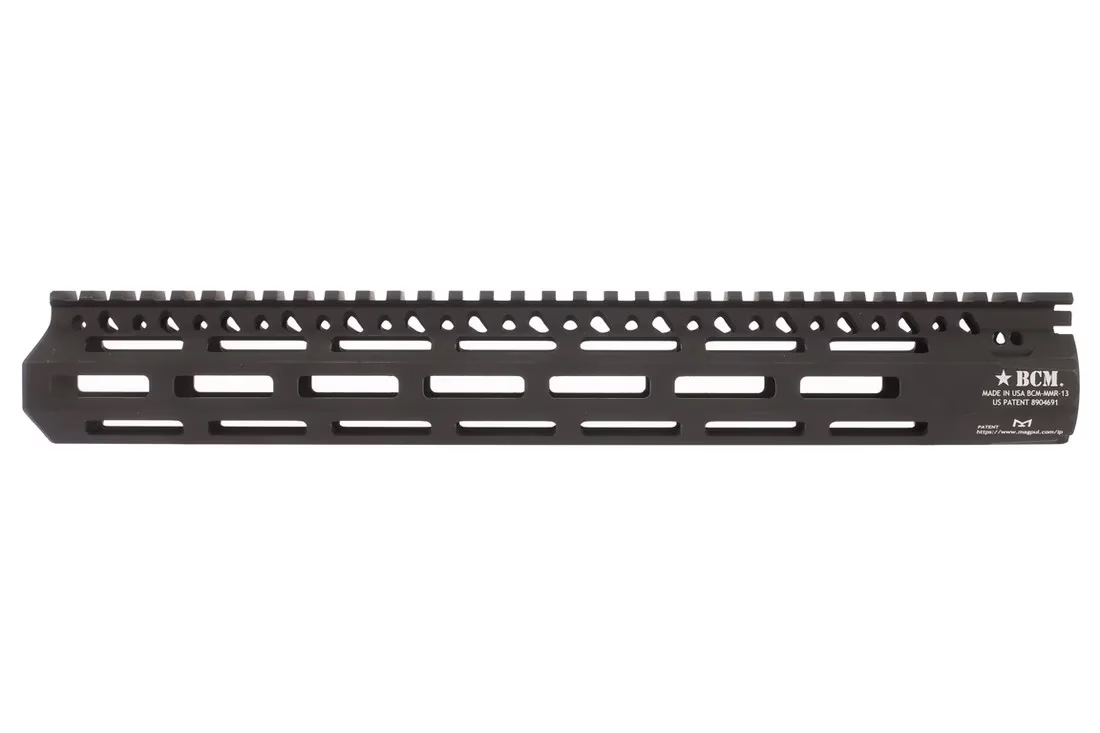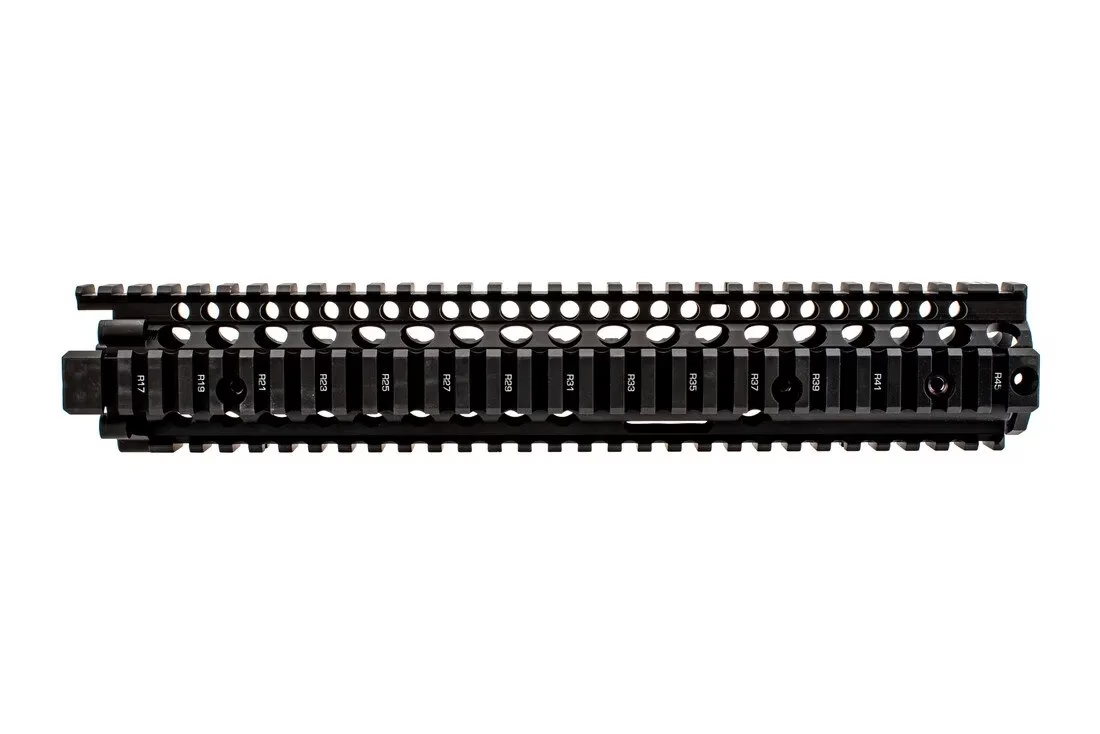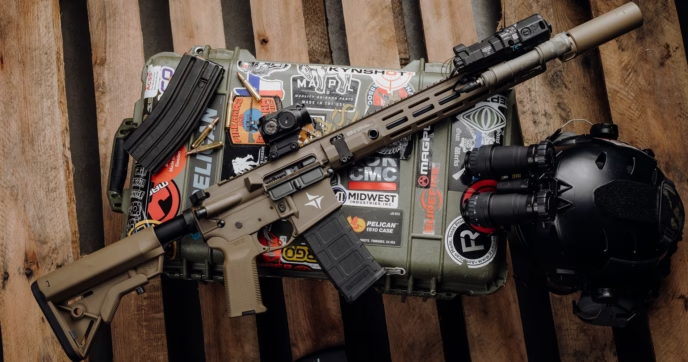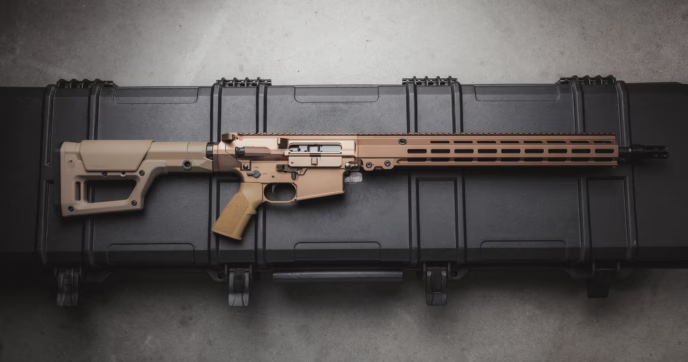One of the most alluring aspects of modern rifles is their ability to be kitted out with different gear and accessories. Modern rifle platforms like the AR-15, AR-10, MCX, and more, most often come with some type of accessory mounting interface built into their handguards.
These mounting interfaces typically exist in the form of either M-LOK or picatinny rails, two of the most common mounting systems around. M-LOK can be seen as the current industry standard, offering a unique and secure mounting system that’s been used widespread since its introduction. Picatinny quad rails have long been popular thanks to their military pedigree, as well as their durable and robust design.
Both mounting systems do their job very well. However, which of the two is best? You might assume that picking one over the other is a simple task, but for many, this decision isn’t always easy as each possibility comes with its own set of advantages.
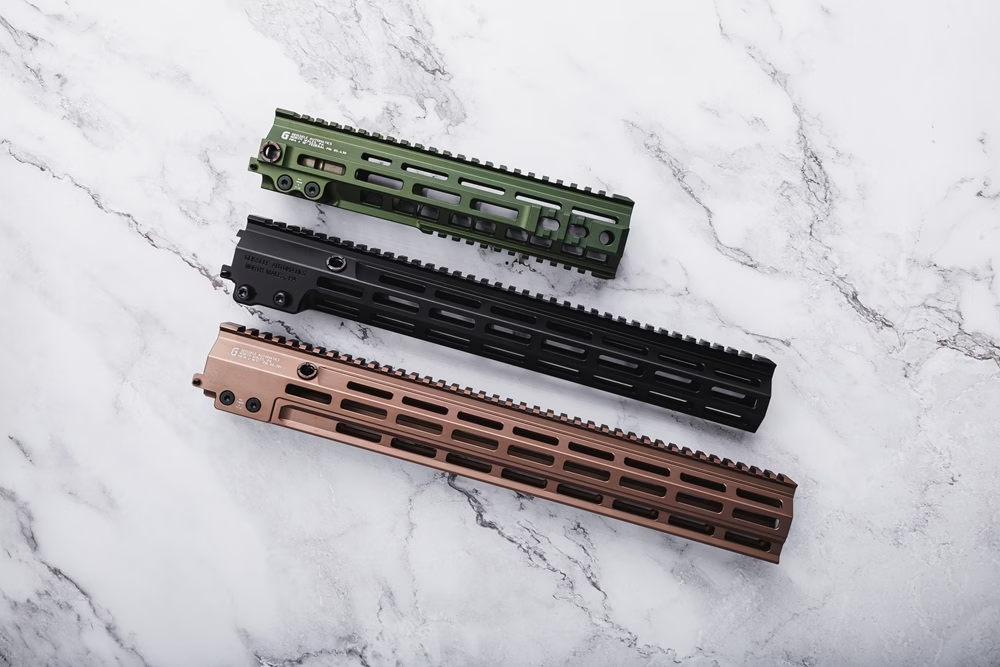
What is M-LOK?
Standing for “Modular Locking System”, the M-LOK mounting interface was developed by Magpul, and is often viewed as the current industry standard for accessory mounting. M-LOK was developed to be the successor to their earlier MOE mounting system, which worked well, but was primarily compatible with their polymer handguards. The M-LOK system has been refined to offer better accessory retention and optimal compatibility with both polymer and aluminum handguards, plus, Magpul even released the design so other manufacturers could create their own M-LOK handguards and accessories, ensuring their compatibility regardless of the manufacturer.
M-LOK handguards don’t have any protruding mounting points, they instead use a series of accessory slots that span the length of the handguard. M-LOK compatible accessories mount to these slots by using screws and T-nut fasteners that fit into them. Once inserted, they rotate perpendicular to the accessory slot and can then get locked down into place. This method of attachment is very secure, but many manufacturers often apply medium-strength thread locker onto the included hardware to further ensure that your gear will stay in place.
Aside from its mounting capabilities, there are a lot of benefits to running M-LOK handguards, but we’ll go more in-depth on them later below.
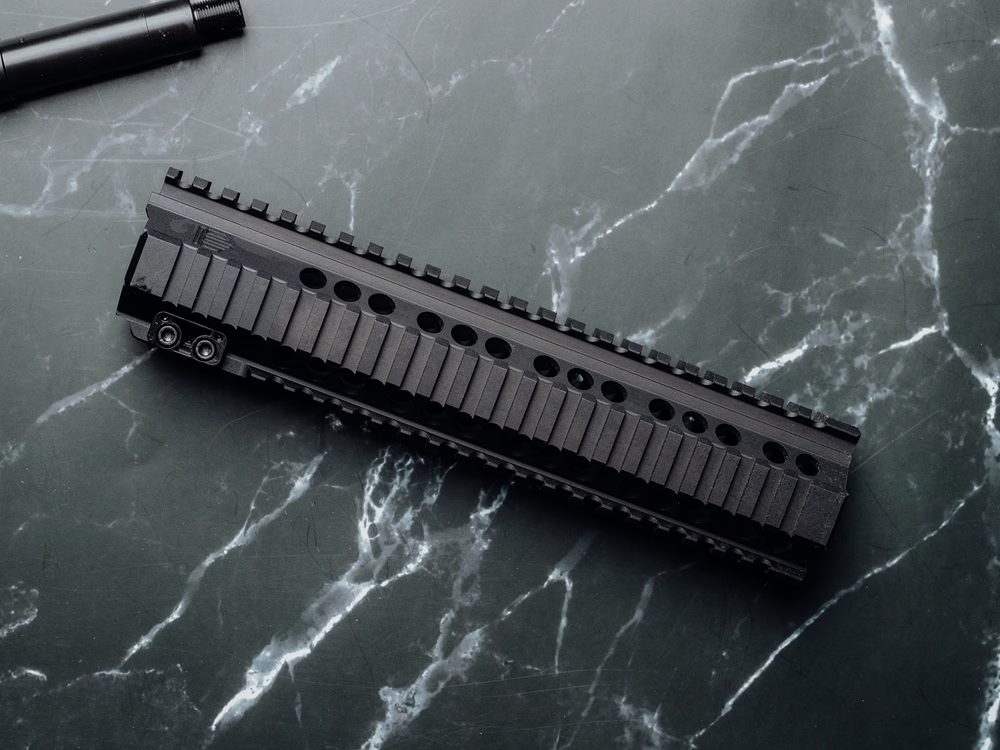
Understanding Picatinny Rails
Picatinny quad rail systems have long been a staple mounting interface, used historically on both free floating and drop-in handguards. They were originally developed to be the successor to the Weaver rail system. Weaver rails, while effective, lacked proper standardization, resulting in some inconsistencies when mounting. This changed once picatinny rails were adopted by the U.S. Military in 1995, as its standardization ensured that there would be no variation in fitment, regardless of the manufacturer.
At their core, a picatinny rail is a hexagonal length of the handguard that has a series of evenly spaced slots perpendicular to the rail. Installation is arguably the simplest of any mounting system—picatinny-compatible accessories are secured to the rail by clamping onto the outer edges of the rails, with the mounting screws fitting within the slots for ideal lock-up. Just like with M-LOK systems, thread locker can be used to ensure that nothing comes loose when firing or when under stress.
M-LOK vs. Picatinny Rail: A Comparative Analysis
Although M-LOK has largely replaced quad rails on modern rifles, picatinny rail systems aren’t completely irrelevant, with them still being used by Military and Law Enforcement groups, as well as civilians. But how do they compare?
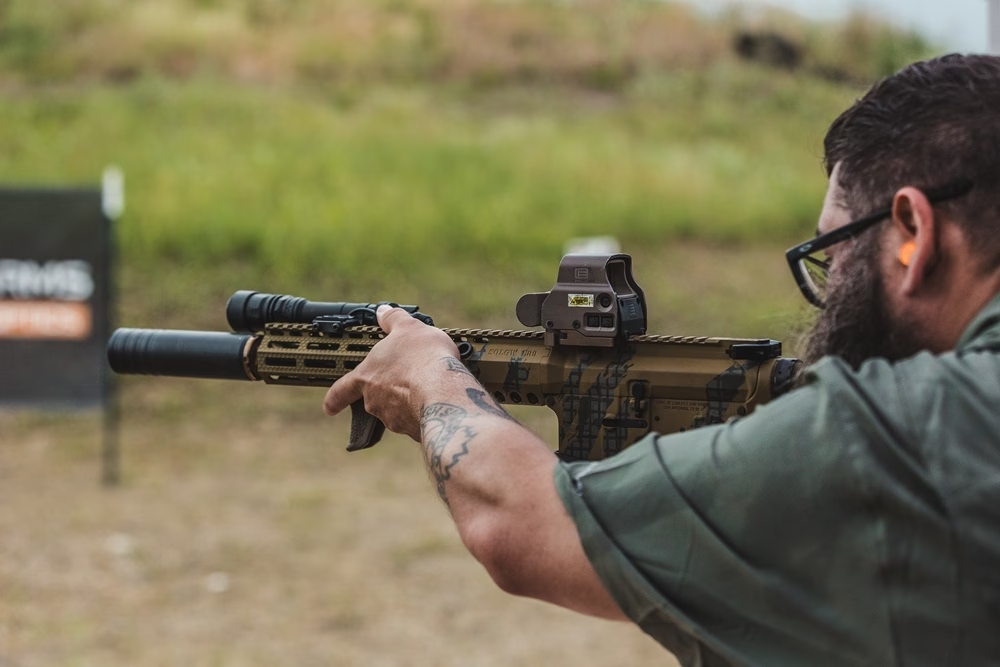
M-LOK Pros
M-LOK rail systems excel in three distinct areas: weight, ergonomics, and accessory availability.
M-LOK handguards are often much lighter than picatinny quad rail systems since they don’t require nearly as much material to serve as mounting points. For example, the BCM QRF-10 quad Rail handguard weighs 12.1 ounces, while their MCMR M-LOK handguard weighs only 6.6 ounces, despite them being the same length—that’s nearly half the weight of their quad rail system.
Even further, the lack of protruding rail sections gives M-LOK handguards a much slimmer profile, making them easier to grip. Also, if you prefer to use a C-Clamp style grip, doing so is typically more comfortable on M-LOK handguards.
Lastly, as the current industry standard mounting interface, there are a lot of M-LOK compatible accessories available. Most, if not all, accessory manufacturers produce M-LOK compatible versions of their offerings, and if you want to use picatinny accessories, you can mount them with no issues by using an M-LOK picatinny rail section.
M-LOK Cons
Although M-LOK handguards have many benefits, they aren’t without their cons. For starters, M-LOK part installation is a bit more complex since you need to properly align the T-nut hardware with the rail system. For those new to this mounting interface, it can be tricky to get everything lined up properly, making accessory installation more time-consuming compared to doing so on picatinny rails.
In the same vein, mounting accessories on M-LOK handguards requires you to more carefully position them in the right spot. Although this is beneficial in that you have more control over the final placement of your gear, it also means you have to put more care into securing them in place to make sure that its final location is where you want it to be.
In all honesty, these are more nitpicks than true cons, but they’re still worth taking into consideration if you’re thinking of using an M-LOK handguard on your next rifle build.

Picatinny Rail Pros
One of the greatest advantages of picatinny rail systems is their durability. This mounting interface has been time-tested and battle-proven for decades, having been used professionally in harsh environments. Their exceptionally solid lock-up ensures that any gear or accessories you have mounted to your rail won’t go anywhere, even when under extreme stress.
Additionally, ever since their design was standardized, hundreds of manufacturers have produced a vast assortment of gear that’s compatible with picatinny rail systems. So regardless of what accessory you’re looking for, it’s more than likely that you’ll be able to find a picatinny-compatible version of it, or a mount for it.
Lastly, installing accessories onto picatinny rails is quite simple. Components simply clamp into place, providing more than enough pressure to keep them securely fixed onto the handguard.
Picatinny Rail Cons
Despite their inherent benefits, picatinny rails are not without their flaws. To start with, these handguards are much heavier and bulkier than M-LOK handguards. As we mentioned above, quad rail handguards are already heavier than M-LOK ones, but once you factor in accessories like weapon lights, IR lasers, optics, and loaded magazines, the overall weight of your rifle can become cumbersome if you aren’t mindful of your gear’s weight.
Another crucial consideration of quad rail handguards is their ergonomics. Picatinny rails protrude past the walls of the handguard, and since they tend to have sharper edges, they aren’t as ergonomic, or as comfortable as M-LOK handguards. Keep in mind that accessories like rail covers can make your quad rail easier to grip, but they can also increase bulk of your handguard, potentially making it more unwieldy in the process.
Conclusion
Both M-LOK and picatinny rail systems have more-than-earned their place as the top accessory mounting interface options, offering battletested reliability and performance. Still, it’s important to recognize their differences when faced with choosing one over the other.
For most enthusiasts, M-LOK is the way to go thanks to its lightweight design, superior ergonomics, and wide accessory availability. Still, picatinny quad rails are a solid choice that offers exceptional reliability and a more simplistic mounting method that’s been in use for literal decades.
Ultimately, the best handguard for you is the one that best aligns with your needs and preferences. Regardless of whether you opt for the modern comfort and efficiency of M-LOK, or the rugged reliability of picatinny based systems, both can be an exceptional option for your next rifle build.
If you’re still on the fence about which mounting interface to go with, our guide, “Daniel Defense – A Reputation of Quality and Performance” has in-depth sections on their handguard offerings, as well as the rifles that use them.
